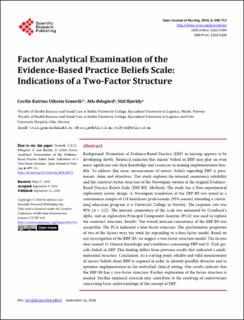| dc.contributor.author | Grønvik, Cecilie K Utheim | |
| dc.contributor.author | Ødegård, Atle | |
| dc.contributor.author | Bjørkly, Stål | |
| dc.date.accessioned | 2023-02-15T10:22:24Z | |
| dc.date.available | 2023-02-15T10:22:24Z | |
| dc.date.created | 2016-09-13T19:25:54Z | |
| dc.date.issued | 2016 | |
| dc.identifier.citation | Open Journal of Nursing. 2016, 6 699-711. | en_US |
| dc.identifier.issn | 2162-5336 | |
| dc.identifier.uri | https://hdl.handle.net/11250/3051012 | |
| dc.description.abstract | Background: Promotion of Evidence-Based Practice (EBP) in nursing appears to be developing slowly. Research indicates that nurses’ beliefs in EBP may play an even more significant role than knowledge and resources in making implementation feasible. To address this issue, measurement of nurses’ beliefs regarding EBP is paramount. Aims and objectives: This study explores the internal consistency reliability and the construct factor structure of the Norwegian version of the original Evidence- Based Practice Beliefs Scale (EBP-BS). Methods: The study has a Non-experimental exploratory survey design. A Norwegian translation of the EBP-BS was tested in a convenience sample of 118 healthcare professionals (95% nurses) attending a continuing education program at a University College in Norway. The response rate was 95% (n = 112). The internal consistency of the scale was measured by Cronbach’s alpha, and an explorative Principal Component Analysis (PCA) was used to explore the construct structure. Results: The overall internal consistency of the EBP-BS was acceptable. The PCA indicated a four-factor structure. The psychometric properties of two of the factors were too weak for expanding to a four-factor model. Based on our investigation of the EBP-BS, we suggest a two-factor structure model. The factors were named 1) General knowledge and confidence concerning EBP and 2) Task specific beliefs in EBP. This finding differs from previous results that indicated a unidimensional structure. Conclusion: As a starting point, reliable and valid measurement of nurses’ beliefs about EBP is required in order to identify possible obstacles and to optimize implementation in the individual clinical setting. Our results indicate that the EBP-BS has a two-factor structure. Further exploration of the factor structure is needed. Further empirical research may contribute to the resolving of controversies concerning basic understandings of the concept of EBP. Keywords: evidence-based practice, beliefs scale, nurses, Psychometric Evaluation, Principal component analysis | en_US |
| dc.language.iso | eng | en_US |
| dc.relation.uri | http://file.scirp.org/pdf/OJN_2016091214062422.pdf | |
| dc.rights | Navngivelse 4.0 Internasjonal | * |
| dc.rights.uri | http://creativecommons.org/licenses/by/4.0/deed.no | * |
| dc.title | Factor analytical examination of the evidence-based practice beliefs scale : indications of a two factor structure | en_US |
| dc.type | Journal article | en_US |
| dc.description.version | publishedVersion | en_US |
| dc.source.pagenumber | 699-711 | en_US |
| dc.source.volume | 6 | en_US |
| dc.source.journal | Open Journal of Nursing | en_US |
| dc.identifier.doi | 10.4236/Ojn.2016.69072 | |
| dc.identifier.cristin | 1381072 | |
| cristin.ispublished | true | |
| cristin.fulltext | original | |
| cristin.qualitycode | 0 | |

